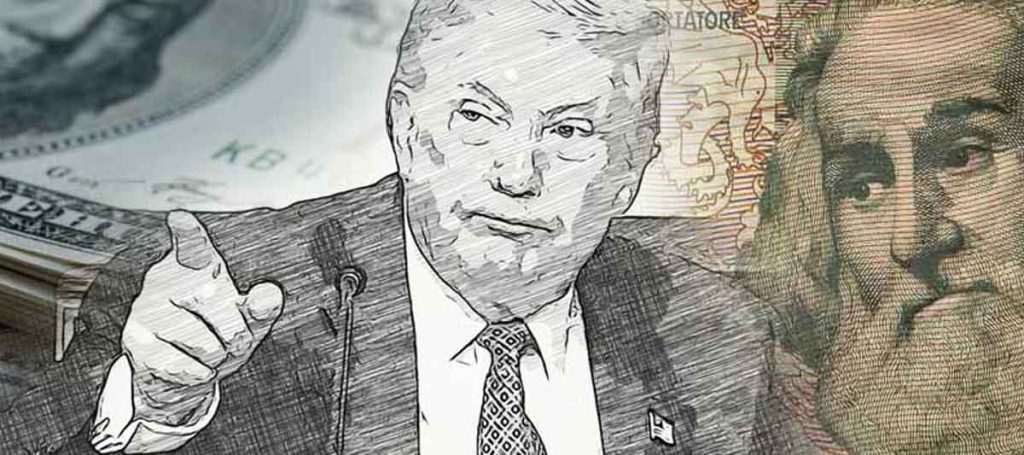Ma davvero c’è qualcuno che può pensare che il progetto Trumpiano di avere un dollaro debole per favorire l’economia americana e le sue esportazioni possa avere un senso? Mi sembra di essere ritornati ai tempi della “liretta” quando si andava avanti a colpi di svalutazioni della lira per coprire le inefficienze del nostro sistema produttivo illudendo gli italiani su recuperi di competitività dell’export e sugli investimenti esteri, il tutto a costo di impoverire il Paese ed importare inflazione (che generava altra svalutazione). La versione ante litteram di “abbiamo abolito la povertà”. Stiamo ancora pagando il conto.
La trumpeconomics si basa su tre direttrici: i) perseguire l’indebolimento del dollaro per favorire le esportazioni; ii) insistere sui dazi per favorire l’industria Usa ed incrementare le entrate pubbliche iii) aumentare il debito pubblico per finanziare una redistribuzione in favore dei redditi più alti. C’è chi dà credito a questa strategia (ma perché stupirsi, c’è chi rimpiange la “liretta”), senza interrogarsi su alcune contraddizioni intrinseche.
Qualche spunto di riflessione da ombrellone. 1)Se indebolisco il dollaro rispetto le valute degli investitori che comprano il mio debito pubblico, dovrò in qualche modo garantire agli investitori che ad ogni scadenza riceveranno un ammontare di dollari che neutralizza la svalutazione, oppure penso che faranno beneficenza al governo Usa e si accontenteranno di un importo che, espresso nelle loro valute, è inferiore? 2) Poiché i dazi generano inflazione e la Banca Centrale non taglia i tassi di interesse ( come giustamente sta facendo), i maggiori interessi pagati dal governo Usa saranno di più o di meno di quanto incassato con i dazi? 3) se i dazi (e non l’efficienza del sistema produttivo) consentissero realmente la re-industrializzazione degli Usa (qualunque cosa voglia dire) dove troverò la forza lavoro, visto che in Usa c’è quasi la piena occupazione? Attraverso l’immigrazione di massa, proprio quella che non voglio? 4) un dollaro debole come può essere compatibile con il progetto Make America Great Again?
Il punto. Trump pensa solo alla sua prossima mossa, e non si interroga sugli effetti successivi.
POOR DOLLAR IN TRUMP’S HANDS LIKE IN THE TIMES OF THE LOW LIRE
But does anyone really think that Trump’s plan to have a weak dollar to boost the American economy and its exports makes sense? It seems to me like we’re back in the days of the “liretta,” when we proceeded by devaluing the lira to cover up the inefficiencies of our production system, deluding Italians into thinking that export competitiveness and foreign investment would improve, all at the cost of impoverishing the country and importing inflation (which generated further devaluation). It was the ante litteram version of “we abolished poverty.” We’re still paying the price.
Trump economics is based on three pillars: i) pursuing a weakening dollar to boost exports; ii) insisting on tariffs to boost US industry and increase public revenue; iii) increasing public debt to finance redistribution toward higher incomes. Some give credence to this strategy (but why be surprised, some long for the “liretta”), without questioning some intrinsic contradictions.
Some food for thought. 1) If I weaken the dollar against the currencies of the investors who buy my government debt, will I have to somehow guarantee investors that at each maturity they will receive an amount of dollars that neutralizes the devaluation, or do I think they will do the US government a favor and settle for an amount that, expressed in their own currencies, is lower? 2) Since tariffs generate inflation and the Central Bank doesn’t cut interest rates (as it rightly is doing), will the increased interest paid by the US government be more or less than the amount collected from tariffs? 3) If tariffs (and not production efficiency) actually allowed the US to reindustrialize (whatever that means), where will I find the labor force, given that the US is almost at full employment? Through mass immigration, precisely the kind of immigration I don’t want? 4) How can a weak dollar be compatible with the Make America Great Again project?
The point: Trump is only thinking about his next move, and isn’t considering its aftermath.


